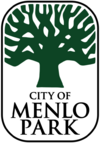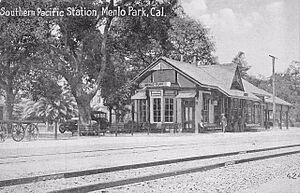Menlo Park, California facts for kids
Quick facts for kids
Menlo Park, California
|
||
|---|---|---|
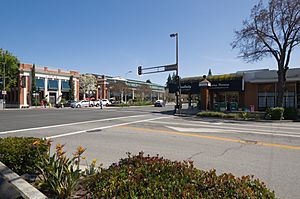
Downtown Menlo Park
|
||
|
||
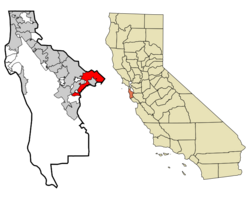
Location of Menlo Park in San Mateo County (left) and of San Mateo County in California (right)
|
||
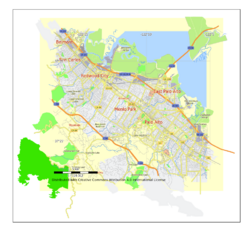
Menlo Park street map, California
|
||
| Country | United States | |
| State | California | |
| County | San Mateo | |
| Incorporated | November 23, 1927 | |
| Named for | Menlo, County Galway, Ireland | |
| Area | ||
| • Total | 17.38 sq mi (45.03 km2) | |
| • Land | 9.99 sq mi (25.87 km2) | |
| • Water | 7.39 sq mi (19.15 km2) 43.79% | |
| Elevation | 72 ft (22 m) | |
| Population
(2020)
|
||
| • Total | 33,780 | |
| • Density | 3,473.3/sq mi (1,341.04/km2) | |
| Time zone | UTC−8 (Pacific) | |
| • Summer (DST) | UTC−7 (PDT) | |
| ZIP Codes |
94025–94028
|
|
| Area code | 650 | |
| FIPS code | 06-46870 | |
| GNIS feature IDs | 1659108, 2411079 | |
Menlo Park is a city located in San Mateo County, California. It's part of the exciting San Francisco Bay Area. The city is surrounded by the San Francisco Bay to the north and east, and by other cities like Palo Alto and Redwood City.
Menlo Park is home to the main offices of Meta Platforms (the company that owns Facebook and Instagram). It's also where famous companies like Google, Roblox Corporation, and Round Table Pizza first started! The train station in Menlo Park is very special because it's the oldest one in California that has been running without stopping. Many people who live here have gone to college, making it one of the most educated cities in the United States.
Contents
What's in a Name?
The name "Menlo" comes from a place in County Galway, Ireland, called Menlo. The original Irish name, Mionloch, means "small lake." Early Irish settlers bought land here and named it "Menlo Park" to remember their home village in Ireland.
A Look Back: Menlo Park's History
The land where Menlo Park now stands was first home to the Ohlone people. This was long before European explorers arrived in 1769.
In 1795, the area became part of a large Spanish land grant called Rancho de las Pulgas.
The Famous Menlo Park Gate
In 1851, two Irish immigrants, Dennis J. Oliver and D.C. McGlynn, bought a large piece of land. In 1854, they built a wooden archway at the entrance to their property. This arch had the words "Menlo Park" and the date "August 1854" on it. This gate was named after their village in Ireland.
The original gate was accidentally destroyed in 1922. However, in 2019, a new replica of the gate was built in front of the Menlo Park public library, bringing a piece of history back to life!
The Railroad Arrives
In 1863, the first railroad tracks were built through the area. The train company named a nearby station "Menlo Park" because of the famous gate. The original station building from 1867 is still standing today! It's the oldest train station in California that has been used continuously.
The town of Menlo Park grew around this busy train station. It became a popular place for businessmen from San Francisco to live. The city was officially formed in 1927.
It's interesting to know that Menlo Park, California, was named before Thomas Edison started his famous laboratory in Menlo Park, New Jersey. In fact, Menlo Park, New Jersey, was named after this California city!
Camp Fremont: A World War I Training Site
During World War I (1917–1918), a big part of Menlo Park became Camp Fremont. This was a training camp for soldiers, with as many as 27,000 men preparing to go to war. The camp didn't last long, but the army engineers helped the city by paving the first streets and laying water and gas lines.
The army kept the camp hospital, which is now a Veterans Administration Hospital. Sadly, in 1918, a flu pandemic hit Camp Fremont and caused the deaths of 147 soldiers.
Dibble General Hospital and Stanford Village
At the start of World War II, the U.S. government bought a large estate in Menlo Park. They turned it into the Palo Alto General Hospital, later called Dibble General Hospital. After the war, some of this land was sold to the city and became the sites of the main library and city hall.
Stanford University also bought some of the land to house the many new students returning from the war. This area was known as "Stanford Village." Later, the Stanford Research Institute (now SRI International) bought more of this land.
Sunset Magazine's Home
The famous Sunset magazine moved its headquarters to Menlo Park in 1951. Their building was designed to look like a California ranch-style house. Sunset called its Menlo Park office the "Laboratory of Western Living."
How Google Began
A very important part of internet history happened right here in Menlo Park! In 1998, the leading internet search engine, Google, was started in a garage in a Menlo Park home. This garage belonged to Susan Wojcicki, and Google co-founders Larry Page and Sergey Brin rented it for their first office.
Menlo Park's Location and Layout
Menlo Park covers about 17.4 square miles. A large part of this area, about 7.6 square miles, is covered by water, mostly from the San Francisco Bay. The city stretches out in a long, narrow shape from northeast to southwest.
The northeastern side of Menlo Park borders the San Francisco Bay. This is also where the Dumbarton Bridge starts, connecting Menlo Park to Fremont on the other side of the bay. The city's shoreline includes a large park called Bedwell Bayfront Park and the Don Edwards San Francisco Bay National Wildlife Refuge.
San Francisquito Creek forms much of the city's southeastern border. The Bayshore Freeway (part of U.S. Route 101) runs through Menlo Park near the bay. Another important road is El Camino Real. The intersection of El Camino Real and Santa Cruz Avenue is considered the heart of the city.
Menlo Park has several neighborhoods. Some well-known ones include Belle Haven (east of Route 101), the Willows, and Sharon Heights. Some areas like Menlo Oaks are very close to Menlo Park but are actually in the surrounding county.
People of Menlo Park
| Historical population | |||
|---|---|---|---|
| Census | Pop. | %± | |
| 1930 | 2,254 | — | |
| 1940 | 3,258 | 44.5% | |
| 1950 | 13,587 | 317.0% | |
| 1960 | 26,957 | 98.4% | |
| 1970 | 26,826 | −0.5% | |
| 1980 | 26,438 | −1.4% | |
| 1990 | 28,040 | 6.1% | |
| 2000 | 30,785 | 9.8% | |
| 2010 | 32,026 | 4.0% | |
| 2020 | 33,780 | 5.5% | |
| U.S. Decennial Census | |||
In 2020, Menlo Park had a population of 33,780 people. The city is known for its diverse community. Many different cultures and backgrounds make up the population.
Learning in Menlo Park
Menlo Park has several school districts for younger students, including the Menlo Park City School District and the Ravenswood City School District. For high school, most students attend Menlo-Atherton High School.
There are also private schools like St. Raymond Catholic Elementary School, Trinity School, and Peninsula School. Menlo School and Sacred Heart School are private middle and high schools nearby.
For higher education, Saint Patrick's Seminary and University is a Catholic seminary in the city.
Menlo Park has two public libraries, the Main branch and the Belle Haven branch. They are part of the Peninsula Library System, which means they share books and resources with other libraries in the area.
Menlo Park's Economy
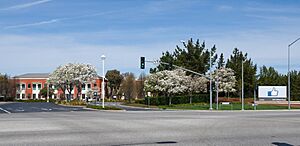
Menlo Park's economy is strongly linked to the companies located on Sand Hill Road. This area is famous for its many venture capital firms, which are companies that invest in new and growing businesses, especially in technology.
Major companies based in Menlo Park include Geron, Robert Half International, Exponent, and SRI International. In 2011, Meta Platforms (then known as Facebook) moved its main offices to Menlo Park.
Top Employers in the City
Meta Platforms is the largest employer in Menlo Park. Here are some of the top employers in the city:
| # | Employer | # of Employees |
|---|---|---|
| 1 | Meta | 18,500 |
| 2 | SRI International | 784 |
| 3 | Grail | 420 |
| 4 | Intersect ENT | 345 |
| 5 | Pacific Biosciences | 320 |
| 6 | United Parcel Service | 277 |
| 7 | Exponent | 238 |
| 8 | City of Menlo Park | 230 |
| 9 | Personalis | 230 |
| 10 | Safeway | 228 |
Getting Around Menlo Park
Santa Cruz Avenue acts like the "Main Street" of Menlo Park. The city is also the western end of the Dumbarton Bridge, which connects Menlo Park to Fremont.
Major highways like U.S. Route 101 and Interstate 280 are close by, making it easy to travel to and from Menlo Park.
For public transportation, Menlo Park has its own train station, served by Caltrain. SamTrans provides bus services throughout the city.
Menlo Park is located between two major airports: San Francisco International Airport (SFO) and San Jose International Airport (SJC). Both can be reached by car or by using Caltrain and other public transit options. Oakland International Airport (OAK) is a bit farther but also accessible.
Famous People from Menlo Park
Many interesting people have lived in or are connected to Menlo Park! Here are a few:
- Joan Baez, a famous folk singer
- Lindsey Buckingham, a musician
- Brandon Crawford, a baseball player for the San Francisco Giants
- Abby Dahlkemper, a professional soccer player and World Cup champion
- Tierna Davidson, a professional soccer player and World Cup champion
- Vince Guaraldi, a jazz musician known for the Peanuts animated specials music
- Jack Herrick, who founded wikiHow
- Ken Kesey, a well-known author
- William R. Larson, who founded Round Table Pizza
- Abraham Maslow, a co-founder of Humanistic Psychology
- Stevie Nicks, a musician
- Sheryl Sandberg, former chief operating officer of Meta Platforms
- Bob Weir, a founding member of the band The Grateful Dead
Sister Cities
Menlo Park has special connections with cities in other countries, called "sister cities":
Images for kids
See also
 In Spanish: Menlo Park para niños
In Spanish: Menlo Park para niños


